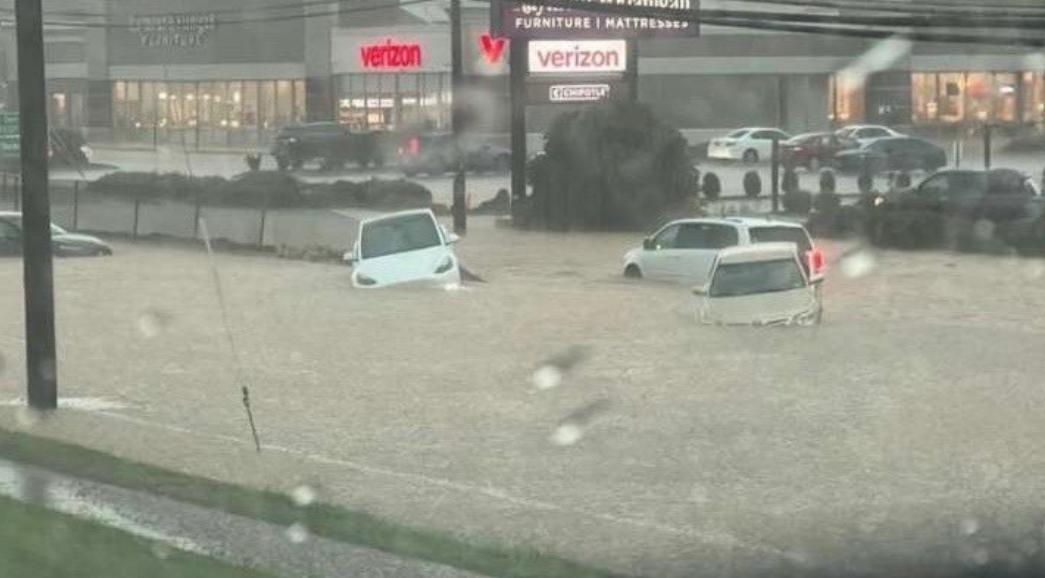Flash Flood Emergency in New York And New Jersey:A powerful storm system triggered devastating flash floods across New York and New Jersey, bringing major cities to a standstill. In Queens, drivers were seen pushing their cars through floodwaters on the Cross Island Parkway, while streets in Scarsdale became hazardous zones due to dangerous hydroplaning. The situation worsened with viral TikTok videos showing water pouring into the 28th Street subway station on the 1 train line, highlighting the collapse of underground infrastructure. In New Jersey, Governor Phil Murphy declared a state of emergency after relentless rainfall flooded highways in Fort Lee and Edgewater, turned roads into rivers, and brought New Jersey Transit trains to a halt.
Flash Flood Emergency in New York And New Jersey
In a dramatic turn of events, flash flooding brought New York and New Jersey to a standstill, turning roads into rivers and transportation into a nightmare. The situation rapidly escalated as severe thunderstorms swept across the region, drenching cities, stranding commuters, and triggering a state of emergency declaration by New Jersey Governor Phil Murphy.
Just hours ago, chaos unfolded on the Cross Island Parkway in Queens where drivers were seen pushing their vehicles through floodwaters. The sudden deluge left dozens of cars stalled, and video footage flooding newsrooms showed terrifying scenes of vehicles nearly submerged. In nearby Scarsdale, streets were inundated, and drivers experienced dangerous hydroplaning as water levels rose swiftly.
The flash flood warnings covered all of Westchester County, with TikTok users capturing shocking scenes from the 28th Street subway station on the 1 train line. Water poured in both from above and below, turning the station into a waterfall and highlighting the vulnerabilities in the city’s infrastructure.
Across the Hudson River in New Jersey, the situation wasn’t any better. In Hackensack, at the intersection of Breeland and Washington Avenue—a known flood-prone zone—residents once again witnessed familiar chaos. As torrential rain poured down, floodwaters quickly rose to about a foot deep. Vehicles, including large trucks, found themselves stuck in the deluge. Although the water has since receded and traffic is moving again, residents remain anxious about the reliability of their commutes and the lack of long-term solutions.

Governor Phil Murphy, responding to the widespread damage and ongoing threat of additional storms, declared a state of emergency. He cited an “abundance of caution” due to the severe thunderstorms and flash flooding affecting towns and highways across the state. In Fort Lee and Edgewater, Route 5 and surrounding roads were particularly hard hit. Pounding rain turned the roads into cascading rivers, with water pouring down embankments like waterfalls. Buses and cars were forced to slow to a crawl as they navigated the treacherous, waterlogged terrain.
In Westfield, the New Jersey Transit system was not spared. A train was halted for nearly an hour due to water on the tracks, leaving passengers frustrated and stranded, their commute extended indefinitely. Such incidents raise concerns about the preparedness of mass transit systems in the face of increasingly frequent extreme weather events.
Residents in Hackensack expressed frustration and concern about the recurring flooding. One local, interviewed live, voiced uncertainty about how she would manage to get to work in the morning if the situation persisted. The intersection she lives near has a long history of flooding, and while water had receded by nightfall, her concerns echoed those of many in the region: Why does this keep happening? Why is there no lasting fix?
Although conditions began to improve in some areas, authorities continued to urge residents to stay indoors and avoid unnecessary travel. Governor Murphy and the National Weather Service both emphasized that staying off the roads would allow emergency and public works crews to complete the cleanup safely and efficiently.
This intense weather event has once again brought into focus the urgent need for infrastructure improvements, particularly in flood-prone zones. With climate change driving more frequent and severe storms, both residents and officials face growing pressure to adapt and invest in resilient systems.
Disclaimer:
This article is for informational and news reporting purposes only. The details provided are based on publicly available reports, eyewitness accounts, and official statements at the time of publication. Weather conditions, emergency responses, and public advisories may change rapidly, and readers are advised to follow updates from official government sources, local authorities, and weather agencies for the most accurate and current information. The blog assumes no responsibility for decisions made based on the content herein. Stay safe and follow all local guidance during weather emergencies.

